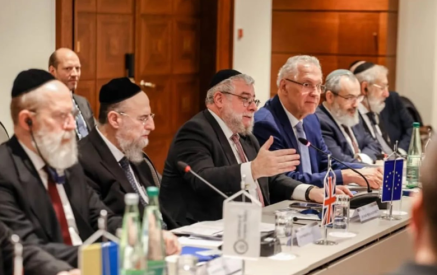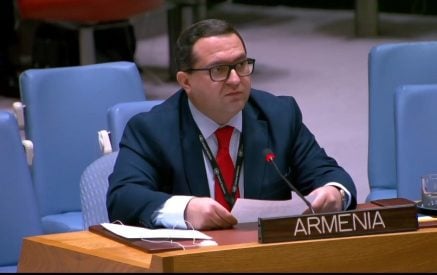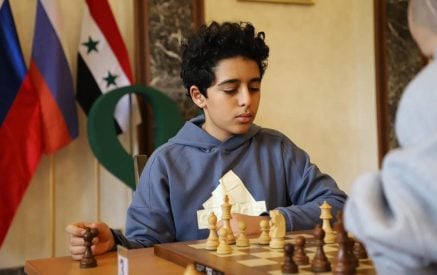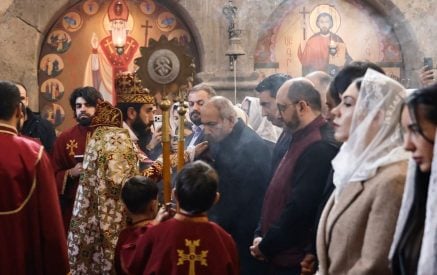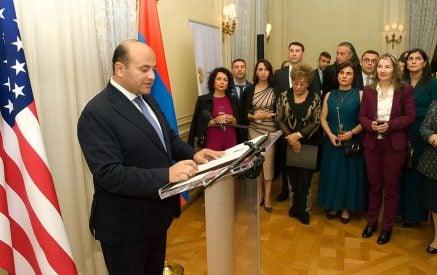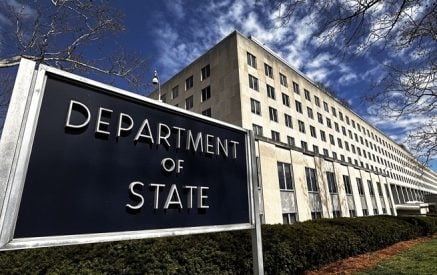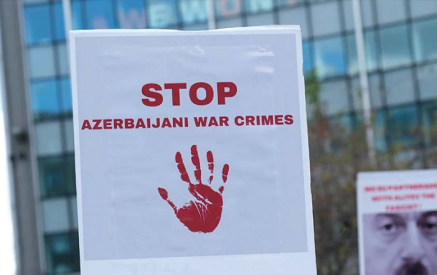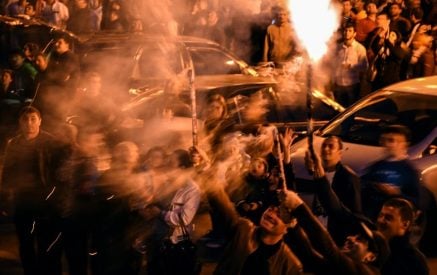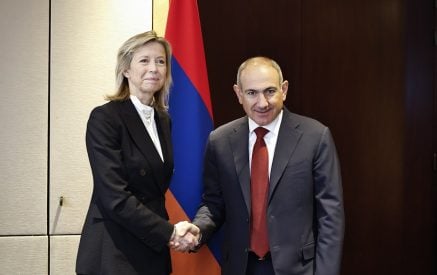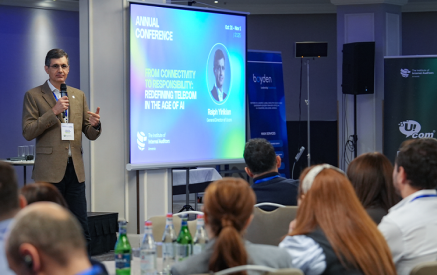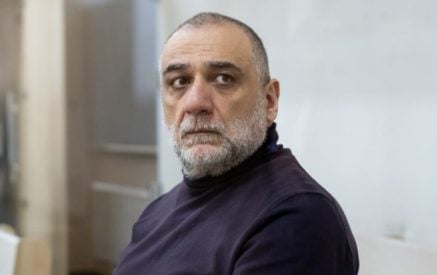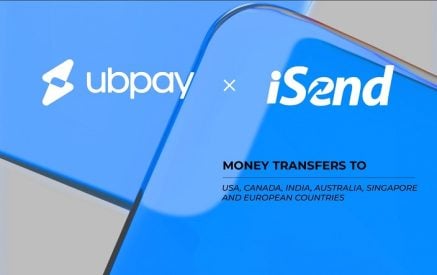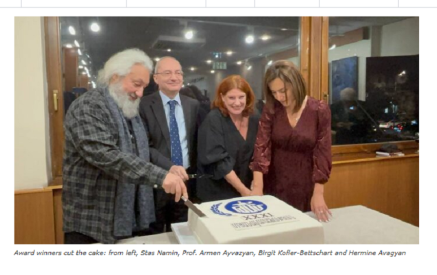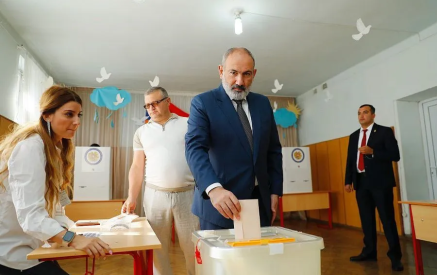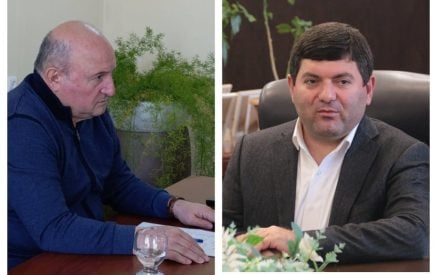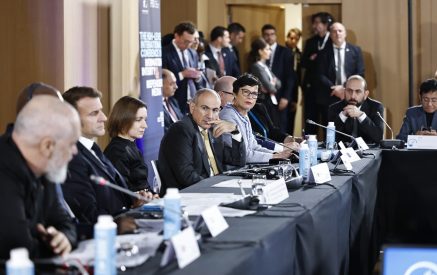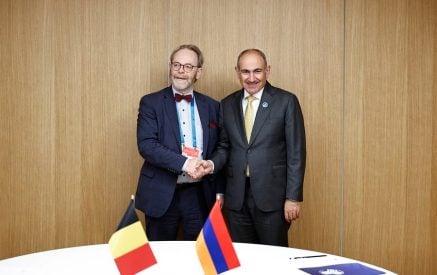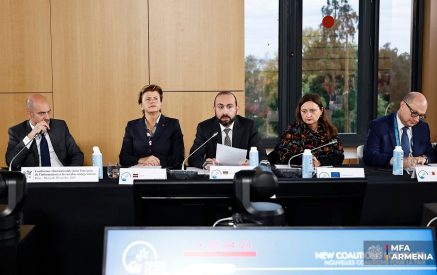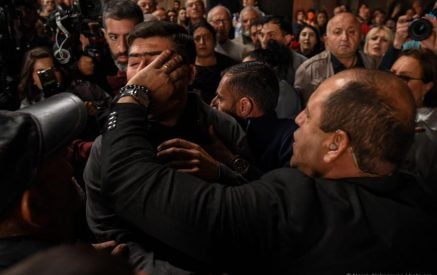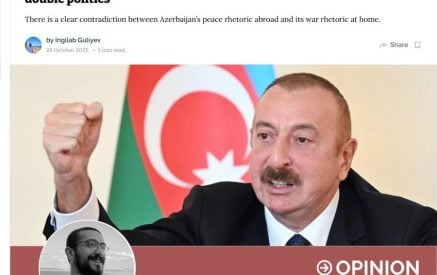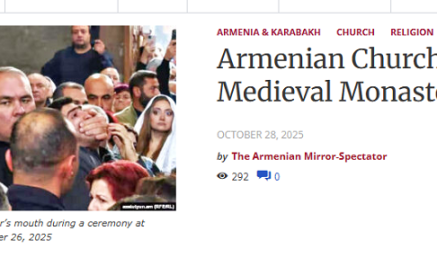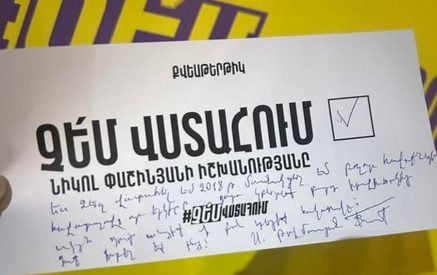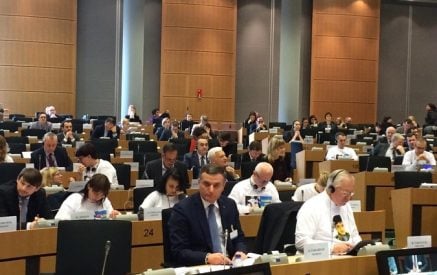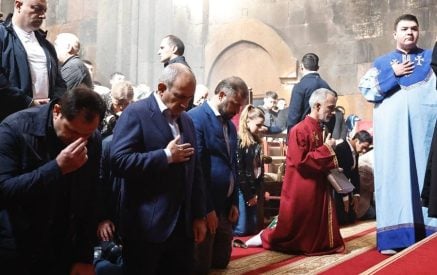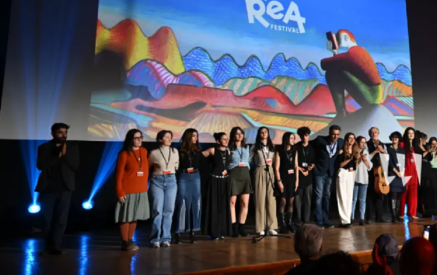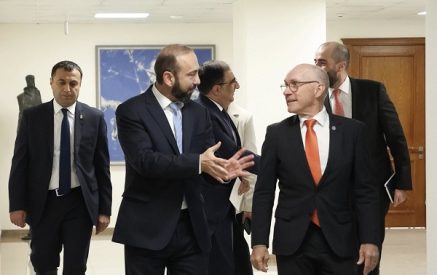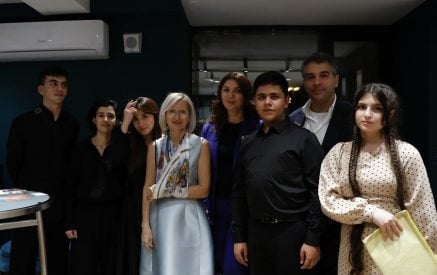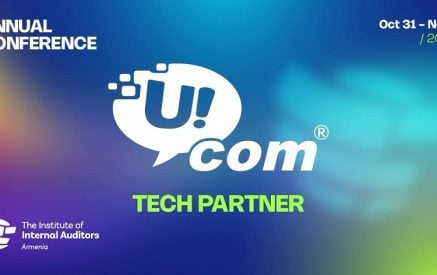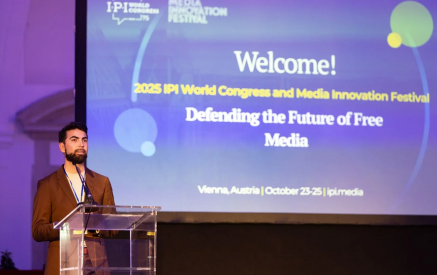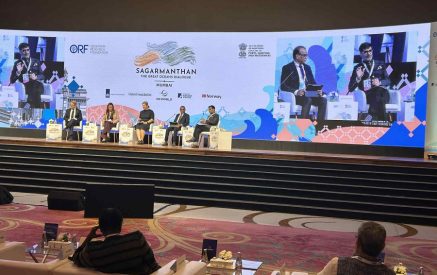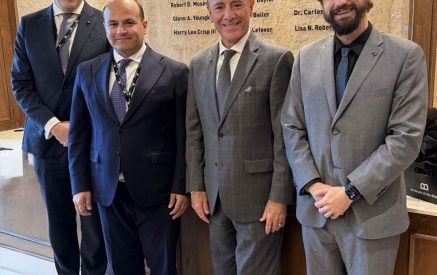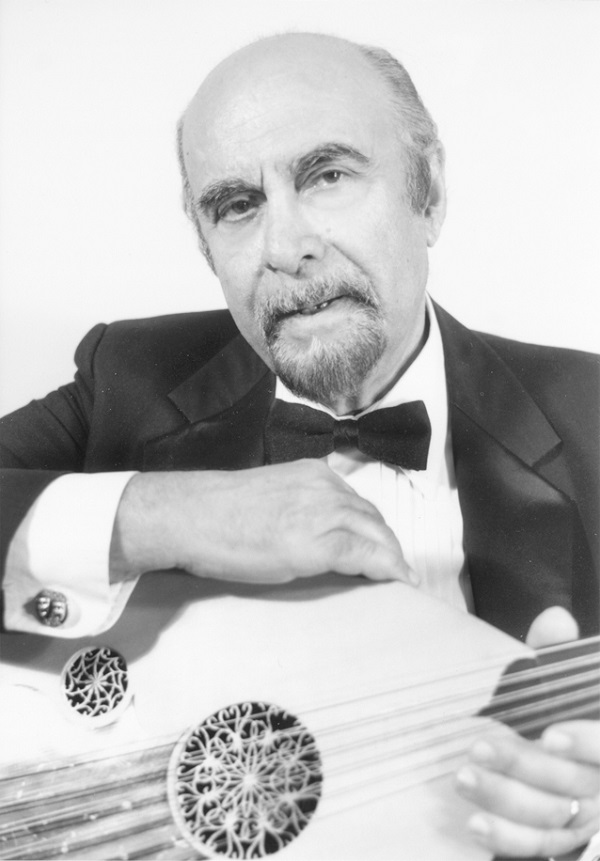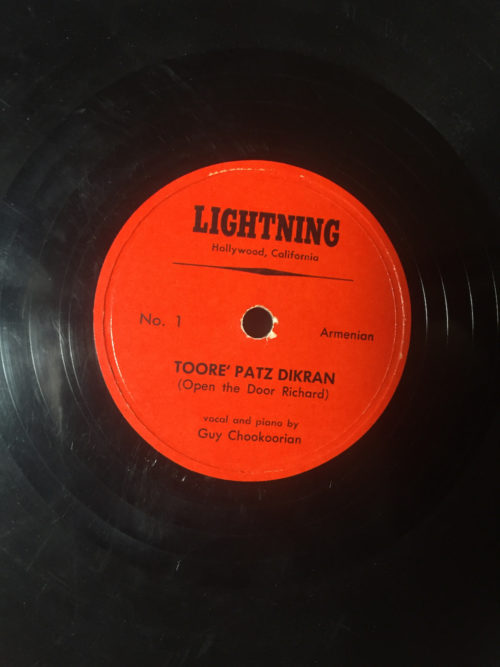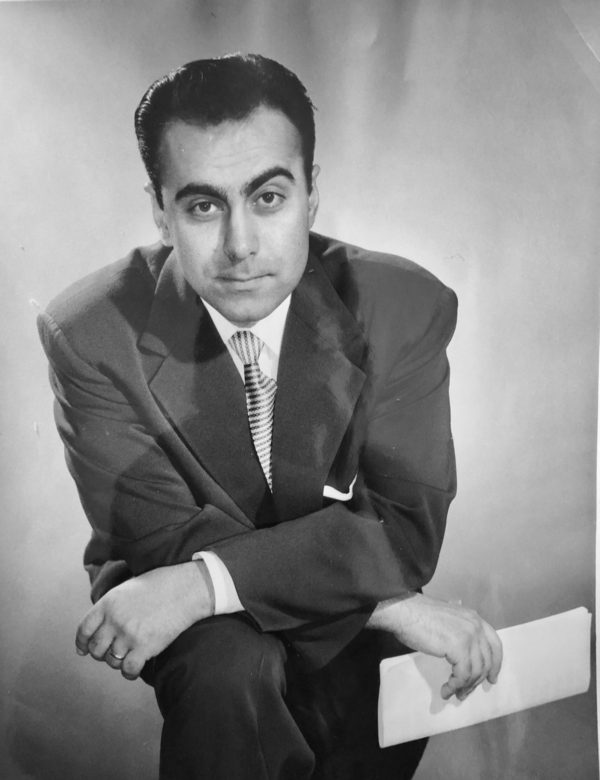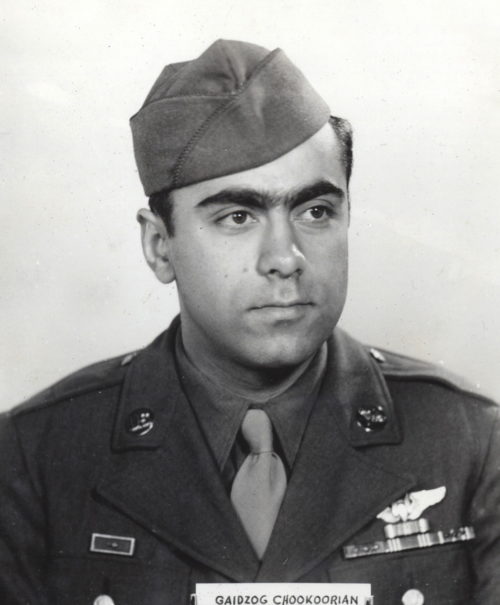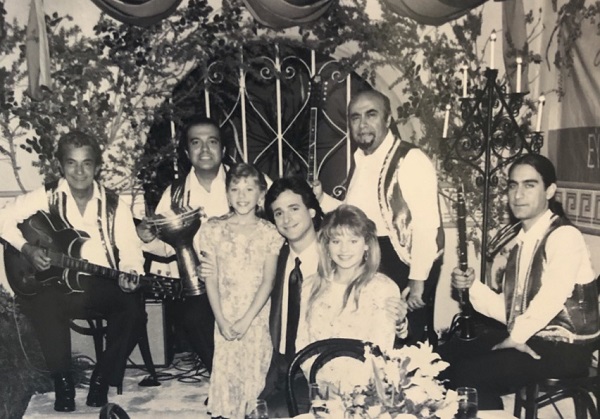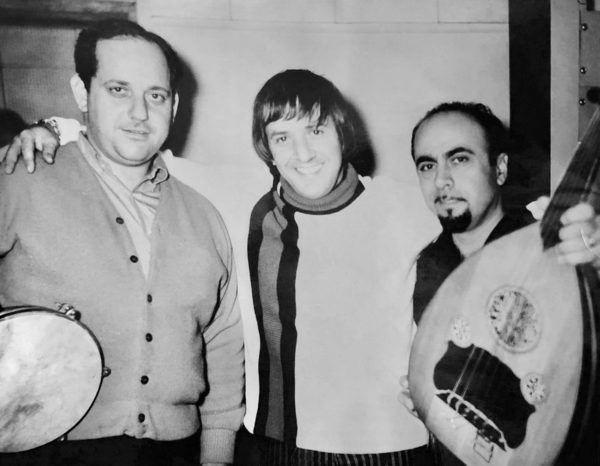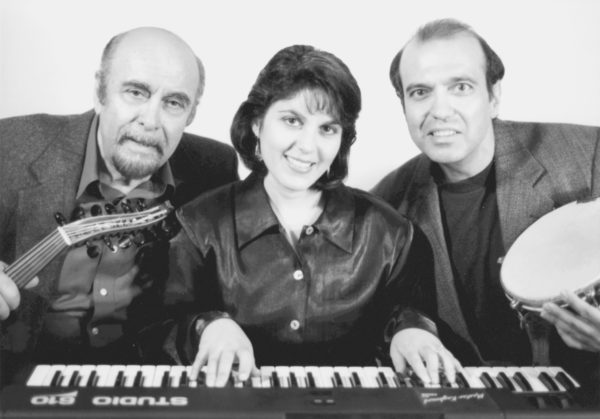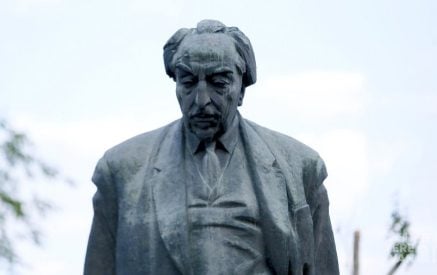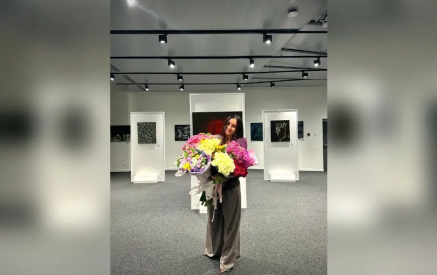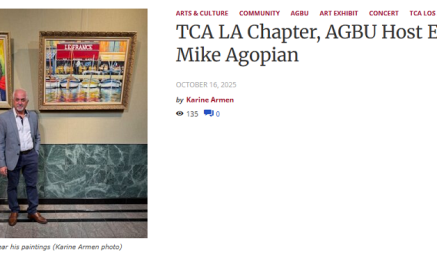Toore patz, Dikran
Toore patz, vor yes ners kam
Toore patz, Dikran
Dikran, inchoo toore ches panar?
The room explodes into uncontrollable laughter. The listeners are surprised and amused at the same time. Even the classical-music snob is a little impressed. Weren’t all Armenians either faux-European 19th century relics, or unreconstructed Anatolian peasants? The question on the minds of many in the room and their peers across the country was how to be modern American young people and remain Armenian at the same time. The voice coming from the record player, singing the latest American jukebox hit, Open the Door, Richard, in fluent but slang-filled Armenian perhaps held the answer. The song’s famous monologue, translated and turned on its head, was now filled with Armenian inside jokes (like the nosy Digin Shadakhosian who yells at the narrator from her window that it’s “khaidarag” to be coming home at 4 in the morning). The group is cracking up. This strange record, by a young man whom nobody (outside of California) had yet heard of, seemed to reflect their generation’s reality, right down to the fact that the singer’s adventure started because “we went to an Armenian dance tonight.” But who was this guy named Guy Chookoorian?
Guy Chookoorian died on January 31, 2021; he was a musician, a comedian, an actor, and a singer. He was an accomplished oud player and Armenian folk musician. He played the piano, mandolin, bouzouki, banjo, and harmonica, and probably other things besides. He wrote and arranged music, and recorded it, in a variety of genres. He helped his father preserve the folksongs of his native region, songs that would have otherwise been lost. Rare for someone born in the US at the time, he wrote bilingual Armenian-American plays. He appeared in Hollywood movies and TV shows. In a less “politically correct” time, he did every ethnic accent imaginable and was cast in every type of role, particularly ones that seemed vaguely to fit his Armenian features.
He had one of the first Armenian radio shows in Los Angeles. As an oudist-vocalist, he was a member of a 50s-era “kef” band, and then fronted his own Armenian dance music group, his own American dance band, and his own belly-dance revue in Las Vegas and Lake Tahoe. He played traditional Armenian dance music for years at picnics, dances, and weddings in Southern California for the generations that loved that music and looked to him to bring to them – along with his signature deadpan comedy. And yes, he was the man who sang Toore Patz, Dikran and on the East Coast he will be forever remembered as such – along with a litany of other Armenian parodies of American songs from the 1940s and 50s.
He was also a religious family man, and a loving father and a grandfather. He was a proud American — a veteran of World War II, a hero with medals from both the US and France. He was a proud Armenian — the choir director at an Armenian Evangelical church, and a mentor to younger generations. He was the son of heroic Genocide survivors from Yerzinga, Western Armenia. He was a member of the first generation of Armenians born in the United States, and in many ways his story is the story of his generation, a generation he helped to shape.
Immigrant Beginnings
Gaidzog “Guy” Chookoorian was born in Kenosha, Wis. on November 15, 1923 to Roupen and Srpouhi Chookoorian. Two years later his sister Dziadzan (Sue) was born. The family soon moved just south of the state line to Waukegan, Ill. Most Armenians in Waukegan were from the village of Tadem in Kharpert. The Chookoorians were from Yerzinga.
Roupen Chookoorian came to America in 1913, leaving his wife Srpouhi in Yerzinga; he was wanted by the Turkish authorities for revolutionary activities. During the Genocide, Srpouhi was initially spared because her family owned a factory that made headscarves and other clothing needed by the Turkish population. Later she fled south into the Dersim where many Armenians were finding shelter with sympathetic Kurdish tribes – while other Kurds were busying themselves with doing the Ottoman government’s dirty work. When the Russian forces invaded and occupied Western Armenia, they arrived in Yerzinga – the furthest point west which they reached – in July 1916.
Srpouhi returned from the Dersim and was enlisted to find Armenian women and children that had been taken into Turkish homes. Under the guise of selling headscarves, she gained entry to the women’s quarters to ascertain the whereabouts of the Armenians. She also helped Mourad with his plan to buy Armenians back from Kurdish tribes. Srpouhi was credited with saving the lives of hundreds. She was also credited with the capture of the notorious “Valibegtsi Mrtashan”, who was responsible for the massacre of numerous Armenian villages, and handing him over to Mourad for justice to be done.
Armenian life began to return in the region, as families went back to their villages and the city of Yerzinga. But not for long. After the Bolshevik revolution, the Russian Army was recalled, leaving only the meager Armenian volunteer units in Anatolia. Mourad set up his own government, attempting to make peace with the local Turks, telling them to reopen their mosques and assigning a Turk as mayor of the city with one Armenian and one Kurd assistant. But the constant attacks of Kurdish villagers, eventually joined by the opposition of the Turks, and finally the approach of the Turkish regular army, forced Mourad to gather the Armenian remnants together and in February 1918 retreat to the Caucasus by way of Erzurum and Kars.
Roupen, ignoring friends who tried to dissuade him from a dangerous mission, travelled to the Caucasus via Poti, Georgia, to find his wife in a refugee camp, and returned with her to the United States in 1921.
Fresno Beginnings
The Chookoorians moved to Fresno in 1936. Whether it was in Waukegan or in Fresno, Guy also attended weekly Armenian school like so many of his generation. But unlike most, he obviously paid attention. Chookoorian’s lyrical genius evinces a much larger Armenian vocabulary than most American-born Armenians could muster. In addition, Chookoorian’s son, Arshag, said when Guy was a kid he would go to the library and check out books on humor and comedy. He was active in the drama department in high school and started to take an interest in acting.
Roupen, opened up a shoe repair shop in Fresno, and continued to play the oud and sing at picnics and other events, as well as the violin, which he played on his lap like a kemanche. Though Roupen was not as in demand as some of the more famous Fresno musicians of the era, his son Guy had a chance to learn the oud by watching his father play. But the young Chookoorian got his real start in entertainment when he was 15 playing cowboy music with another Armenian friend, Gil Abcarian, on a Fresno radio station. In between the announcements the duo “Guy and Gil,” would play guitar and fiddle, respectively, sing cowboy songs and tell cowboy jokes. Chookoorian dreamed of getting into the entertainment business, but his mother thought he ought to go to college and become a doctor. He attended college briefly and then in December of 1942, a year after the US entry into WWII, the 19-year-old Chookoorian signed up with the military.
Because Chookoorian enlisted voluntarily rather than waiting for the draft, he was able to choose what branch of the service he wanted to enter. He chose the Army Air Corps and became a radio operator and gunner on a B-17. As a member of the 331st Bomb Squadron of the 94th Bomb Group, Chookoorian flew 32 missions over Europe. Arshag pointed out that “they usually let you off after 26 missions, but they needed my dad’s crew.”
On one mission, the entire squadron was blown out of the sky except for two planes. One turned back. Only Chookoorian’s continued and completed its bombing mission.
Chookoorian rose to the rank of Technical Sergeant and was decorated with numerous medals. One very special honor Chookoorian received was due to the fact that on seven of his 32 bombing missions, his crew dropped supplies to the French Resistance to aid in their fight against the German occupation. In 2017, Chookoorian was awarded the French Legion of Honor rank of Chevalier (Knight), one of ten veterans from Southern California to be so recognized.
Hollywood Bound – And Sidetracked
After the war was over in 1945, Chookoorian moved to the Los Angeles area to try and get an acting job in Hollywood. It was difficult for him being away from his family, but he connected with the local Armenian community, which was relatively small at the time. He became popular as a stand-up comic at Armenian community events and banquets. One of the acts he came up with was to parody the rhythm and blues jukebox hit song Open the Door, Richard, which was so popular at the time that five different recordings of it by different artists charted in early 1947. Chookoorian changed the singsong refrain to Toore Patz, Dikran and transformed the monologue into Armenian complete with references to a barahantes, a nosy Armenian lady, and surprise ending that’s only in Chookoorian’s version, all delivered in rapid-fire, slightly dialectal Armenian with a lot of slang. Someone commented to Chookoorian that if he had a recording of the song, they would buy it. Chookoorian approached the Andonian Sisters, a popular Russian-Armenian musical act at the time who used to cut records, and asked them how many they generally sold. Hearing that they typically sold around 200 records, Chookoorian was underwhelmed, but reckoning that he would break even if he sold that many, decided to take a chance. In 1947 he recorded the song and had 500 copies produced.He brought a box of copies to an Armenian 4th of July event and got up and performed the song. Chookoorian was amazed when he ended up selling a few hundred copies just that weekend. Soon he was getting calls about the record from places like Detroit and Chicago. Armenian record dealers in New York, Rhode Island, Detroit, Chicago, Milwaukee, San Francisco, Fresno, and Los Angeles were all putting in huge orders. Chookoorian ended up selling at least 3,000 copies of the record, which was phenomenal for an Armenian record at the time. Bootleg copies seem to have made it as far as Beirut. More importantly, Chookoorian was the first Armenian popular musician of his generation in the US to cut a record; Onnik Dinkjian and the Vosbikian Band would follow in the next couple of years.
Toore Patz, Dikran was followed by Dzukhe Dzukhe Dzukhe (Smoke, Smoke, Smoke that Cigarette by Tex Williams, 1947); Vaghuh (Mañana by Peggy Lee, 1948); Harsnikid Bidi Barem (I’ll Dance At Your Wedding, also by Peggy Lee, 1949); Choriner (Mule Train by Frankie Laine, 1950); and Yegoor Im Doonus (Come On-A My House, made famous by Rosemary Clooney, 1951). In all cases, Chookoorian not only translated the songs into Armenian but dropped inside jokes and references to make them even more funny; in Dzukhe Dzukhe Dzukhe the singer finds himself on a date and hearing that the girl is in possession of 40 acres of land, declares suddenly in English, in an Armenian accent “But I vanted to marry her just de same.” In Vaghuh, sister Sue mentions that she burned the house down while cooking pilaf; in Harsnikid Bidi Barem Chookoorian declares that not only will he dance at your wedding, but he’ll do the Tamzara, continuously drink and carry on with the young women, and just for the sake of the patented Chookoorian deadpan absurdism, will “carry water in sieves” (an Armenian idiom for a fruitless task) and “slice basturma.” In Choriner the mule train knows well the road from Yerzinga to Arapger.
The flip sides of these records mostly featured more traditional folk-type material, which sometimes also had comedic lyrics by Chookoorian, sung by his sister, Sue Chookoorian. The flip side of Vaghuh was a song called The Four Note Bar, commonly known in kef music circles as Yega Yega Yaris Mod, Sue and Guy sang various folk verses that fit with the melody and then end with a verse in English slyly referencing Chookoorian’s sudden popularity among Armenians across the country
The flip side of Choriner is an interesting story. Entitled Amoosini Voghperkuh or The Husband’s Lament, it’s an original melody and lyric written by Chookoorian based on a suggestion from Assyrian dumbeg player Joe Elby. In the song a man describes the various “hardships” he has dealt with since getting married, such as his wife’s cooking: “the bread is like a rock, the coffee is like mud, and the chicken is like wood,” ending by warning young men to flee at any mention of the word “daros” (a wedding greeting meaning “may you be next”)! With a very catchy Armenian-type melody, and lyrics, which though comical, are not as absurd or satirical as Chookoorian’s other songs, Amoosini Voghperkuh could perhaps pass for an Armenian folk song. And that is what many people for years assumed it was, with artists like the Vosbikian Band and others covering the song without any knowledge that it was written by Chookoorian himself. Chookoorian would politely call these artists to say that he didn’t need any royalties, but he would appreciate it if they credited him as the composer.
The recording of Yegoor Im Doonus (Come On-A My House) had as its flipside No Real, a hilarious English version of the Armenian song Sood eh, Sood eh, where Chookoorian impersonates an old country singer performing the well-known kef song in broken English. As usual, Chookoorian parodies the actual lyrics. This disc led to one of Chookoorian’s interesting encounters. He always asked permission to record a parody, and in this case, the songwriters demanded a meeting with him, which didn’t usually happen. The writers of Come On-A My House just happened to be William Saroyan and his cousin Ross Bagdasarian, the creator of Alvin and the Chipmunks. And so Chookoorian found himself in Saroyan’s swanky Beverly Hills office, conversing with the two fellow Fresno Armenians. Saroyan was much older; he had left Fresno almost before Chookoorian was born. Bagdasarian was a little older than Chookoorian, they knew each other from Fresno, but had been in different age brackets. After giving permission for the use of Come On-A My House, they found out about Chookoorian’s English version of Sood Eh. Recognizing his talent, they suggested forming a 3-way partnership to write more English versions of Armenian songs. Unfortunately, Bagdasarian and Saroyan had a falling out soon after, and this never came to pass.
Marriage, Family, and Armenian Heritage
In 1951 Guy Chookoorian married Louise Paul (Bogosian) who came from a strong Armenian-Protestant family. Her grandfather had been a minister back in Turkey and was martyred in 1915. With his marriage came Chookoorian’s longtime involvement in the Armenian Protestant community. For more than 50 years he served as the choir director of the Immanuel Armenian Congregational Church, originally in Los Angeles, and later in Downey, Calif. His wife served as the organist, a role she already held at the time of their marriage.
The couple had two children, Arshag and Araxie, both of whom would follow in their father’s musical footsteps and eventually join his band. Although Chookoorian was still trying to break into Hollywood acting, he had to pay the bills for his growing family. He held a number of jobs, but the longest-lasting one was cleaning swimming pools for Hollywood’s elite in the backyards of their Beverly Hills homes. With clients like Rudy Vallee, and the young John Ritter and Ron Howard, Chookoorian had many interested encounters.
It was in 1952 that Guy’s father, Roupen Chookoorian, was commissioned by an Armenian organization to document the songs of his native Yerzinga by pressing them on record. Roupen, playing oud, enlisted the help of his son Guy and daughter Sue and one or two other musicians for this project. Ten songs were recorded; nine of them were specific dances that were native to the region. Yerzinga dances are known for a few things; first of all, unlike the vast majority of Armenian line dances, they move to the left rather than to the right; secondly, the dance Tamzara and the 9/8 beat it uses was very popular in Yerzinga, to the point where they had multiple dances with this odd rhythm; thirdly, some European folk dances such as the Polka had made inroads into Yerzinga and were included as folk dances, as Armenians had developed their own variations of these.
In 1955, Guy Chookoorian chose to record a final Yerzinga song, the very well known dance, Ghosh Bilezik, which having a Turkish name, he simply titled The Golden Bracelet. This was actually used as the flipside of one of his best parodies, Davit Amoo (Uncle David, a parody of The Ballad of Davy Crockett). In this song, Davit Amoo is a humble Armenian peasant from Kharpert (who killed a bear when he was only three), who comes here from the “yergir” (old country) in ’20, buys a vineyard in Fresno, and attempts to harvest raisins, but loses money when the price of raisins goes down. Our hero then moves to Los Angeles, gets married, starts a rubbish business, makes money, builds a madzoon factory, becomes a millionaire, and then looks for a vineyard in Fresno to retire on.
The New Generation Comes Of Age
Meanwhile, Chookoorian was trying to live his dream of breaking into Hollywood. His dark Armenian features made it possible for him to play any number of ethnic types and “heavies.” His ability to do accents also helped. But it seemed he was having more success with Armenian novelty records than with getting acting jobs. He had tried to write a radio show in 1947, but it didn’t go anywhere. He got into Armenian community theatre by writing a play called “Gesoorus” (My Mother-In-Law) with Leo Danielian. It was a three-act musical comedy half in English and half in Armenian, and Chookoorian was in charge of the music. There have been a handful of plays like this that were written in the late 40s and early 50s, rare instances of American-born Armenians of that generation writing original material in the Armenian language. Chookoorian’s play was intended to have enough dialogue in both languages so that everyone would understand what was going on, regardless of their linguistic ability. Chookoorian later reused some of the music he wrote for this play in his albums.
Another project of Chookoorian’s in the 1940s or 1950s was an Armenian melodrama – with a classic evil villain, perhaps trying to tie the female lead to the railroad tracks – which Chookoorian attempted to film. Unfortunately, this 1950s Armenian-American movie was not to be; Chookoorian’s actors, members of his own generation, could not read Armenian and Chookoorian had to write out the lines phonetically. That wouldn’t be so much of a problem, but while the young men and women could understand Armenian and speak it a little, they didn’t speak very well and many of them had strong American accents. Ultimately, the movie project was a flop.
The language issue was coming to a head in 1954 — Peniamin Noorigian’s independent New York Armenian literary quarterly Nor Kir was discontinued and writers who continued to create in the Armenian language began to look toward Beirut to have their works published rather than anywhere in the States, as had previously been the case.
His wife’s aunt, an older woman from Erzurum, used to play the mandolin for her Armenian women friends of her generation. She asked Chookoorian if he would translate You Are My Sunshine into Armenian for her. He did a very nice translation. Then he recorded it himself. Although the main part of the song is done straight, in the middle Chookoorian breaks into a hilarious monologue where the narrator is the victim of a crazy wife who takes all his money. But the real comedy was on the flip side. Chookoorian came up with an idea and then sat down with his mother-in-law to play it for her. He played a somber funeral march-like tune while going into an Armenian patriotic monologue: “Sireli hayrenagitsner” (Dear compatriots), he began, continuing to say that it was unfortunate that the new generation does not speak Armenian well, and some even struggle to understand it. They can tell people they are Armenian, and when asked what foods Armenians eat, they reply “shish-kebab, pilaf, etcetera.” To which Chookoorian deadpans “we know what shish-kebab is, and we know what pilaf is, but what is this so-called etcetera?”
Chookoorian’s mother-in-law flipped out laughing, and he knew he had a hit with what he titled Nor Serounti Yerkuh (The New Generation Song). But that disc and the one that came after it (Davit Amoo) were to be the last of the old school Armenian novelty records on 78 rpm discs. New things were brewing in the Armenian community. For one thing, 1954 was by some estimates the year that the new generation of Armenian bands on the East Coast, like the Vosbikians, the Gomidas Band, and the Artie Barsamian Orchestra, really started to take over the music scene in the Armenian community.
Chookoorian continued to be an innovator. He hosted what was probably the first Armenian Radio Hour in Los Angeles, “Hye Time,” on which he played Armenian music and also interviewed Armenian celebrities, like Ross Bagdasarian. It only lasted a few months, due to lack of sponsors. Then something amazing happened. A cover of an Armenian kef song, entitled Shish Kebab hit number 10 on the pop charts in 1957. The original disk, unfortunately retitled Harem Dance by “the Armenian Jazz Sextet” (it was actually “Arax Bar” by the “Arax Band of Detroit”) also got into the top 100. Chookoorian thought to himself that maybe, just maybe, Americans were ready for Armenian music.
Chookoorian prepared two songs using the best recording studio – Gold Star Studios in LA, where Bagdasarian recorded, and where Phil Spector would later create the Wall of Sound and the Beach Boys would record “Good Vibrations” – and rather than utilizing Armenian kef musicians, he used highly talented session musicians, jazz and big band players who were veterans of the Tommy Dorsey Orchestra and similar big name groups. The 45 single they produced was Opal From Constantinople. The orchestration was great, including a Middle Eastern style clarinet solo that Chookoorian wrote out for the musician. The flipside Armenian Rock was a sort of jump-blues version of Armenian folk classic Im Chinari Yaruh. It got some airtime on the West Coast and got written up in Billboard but that was the end of that.
Chick Ganimian and Onnik Dinkjian’s Daddy Lolo/Halvah released the following year had a similar experience on the East Coast. Apparently the success of “Shish Kebab” was a fluke, and the public was not ready for Armenian music.
Becoming Guy Chookoorian, Oud Player
It was around 1958 that Chookoorian was asked to join a new LA-based Armenian band, the Barrites, as oud player. The Barrites were Southern California’s answer to East Coast bands. Their goal was to play Armenian dances, picnics, and weddings. They also got involved in playing the burgeoning belly-dance scene.
Listening to current oudists of his generation, like Chick Ganimian and George Mgrdichian, he began to develop his style. To the end, Chookoorian respected Richard Hagopian, who was just becoming popular locally at the time, as the greatest Armenian oud player in America. But the younger generation of Armenians in Southern California didn’t want just Armenian music. They wanted a band that could play American standards. This was something the Barrites weren’t really capable of. So Chookoorian assembled a group of musicians, veteran swing jazz players, to play the dance standards and switch off with the Armenian group at events where both styles were in demand. Simultaneously, he learned to play bass guitar so that he could direct the American group.
After a few years of this Chookoorian got involved in other projects, but the real turning point was the death of his father and sister both in 1962. It was a real blow; he took a break from his day job. And then as one door closed, another opened. In 1963 he got a call from the Flamingo Hotel in Las Vegas. They were looking for someone to lead the music for a belly-dance revue called “Cleopatra and the Nymphs of the Nile,” which was to have 7 dancers. Chookoorian brought a group of professional non-Armenian session musicians. He wrote charts for the 7 piece group for Armenian, Arabic, and a few Turkish songs. Chookoorian developed a repertoire which was a combination of Westernized Armenian and Arabic music, along with Greek songs, and popular Mediterranean “ethnic” hits like Misirlou and Never on a Sunday.
The first gig lasted only a few months. But no matter; Chookoorian ended up getting called for a different casino job. He developed the Guy Chookoorian Middle Eastern Revue, based on the swing jazz players he had been hiring. For Armenian weddings, dances, and picnics in Los Angeles he had the Guy Chookoorian Armenian-American Band. Again, the same musicians or the same type of musicians were part of this band. With this double-pronged approach, Chookoorian made music his full-time job for the rest of his life.
Chookoorian played Vegas, Reno, and Tahoe. He toured the Western States and Canada. He had the longest running lounge act at the Aladdin, 7-8 months. He played for the Armenian community in Los Angeles, Fresno, and all of California. He even appeared as a session musician at times – memorably playing oud on a track called Love Don’t Come by Sonny and Cher. Sonny Bono wrote it and thought it would be a hit, but it ended up being the B-side of The Beat Goes On.
Chookoorian couldn’t stray far from his roots and his personality. He started to incorporate comedy into his act again. One day he was working at a supper club in Fresno called the Arabian Nights (owned by the Harootunian family) with the pianist Wayne Bedrosian and a drummer. There was an old cowboy hat someone had left on the ground, so he put it on his head and started to play cowboy music on the oud. Then he started telling cowboy jokes, just like he did as a kid on the Fresno radio. From then on, comedy once again became an integral part of his act.
Always Evolving
In the 1960s, an Armenian immigrant named “Happy” Harry Hadigian started a new Armenian Radio Program. While Guy had difficulty getting sponsors in the 1950s, Hadigian was able to get sponsors from the Armenian and also Arab community. Chookoorian and Hadigian were great friends; Chookoorian helped Hadigian with legal issues so he could stay in the country and also did some of the advertisements on the radio show since Hadigian’s had a heavy accent. “Happy” Harry’s radio show lasted for over 25 years in the Los Angeles area.
In 1971 Chookoorian produced his only LP, “Guy Chookoorian Does His Hits.” He re-recorded Toore Patz Dikran and several other of the parody songs for a new generation.
When Chookoorian started his revue, it was composed of Guy on oud, a drummer, pianist, saxophonist, trumpet player, and maybe a second sax or a dumbeg. Aside from the American big-band musicians, a very talented Greek dumbeg player named Gust Aspiotes often played with Chookoorian – until son, Arshag Chookoorian, got old enough to join the band. Chookoorian taught his son Arshag to play dumbeg at age 7. At 15 years old, in 1970 Arshag joined him on stage, though he wasn’t allowed to play for belly-dancers until he was 18. At that time, in October 1974, he booked a gig at Hadji Baba’s in Inglewood, owned by Harry Akulian. Said to be one of the best Armenian-American restaurants in the country, Akulian was a butcher who only served the best meat. He recognized Chookoorian’s talent and unlike some club owners never bothered him about anything.
As the influx of new Armenian immigrants created an Armenian boom in Los Angeles in the late 1970s and 1980s, Guy Chookoorian was one of the few of the old guard of Armenian musicians that survived. “Continental” Armenian pop music, born in Beirut, was transplanted to Southern California after the ravages of the Lebanese Civil War starting in 1975. Chookoorian was a symbol for the old-line Armenian generations who preferred the traditional sound of the oud and the traditional line dances.
Because Chookoorian, along with John Bilezikjian, and one or two other bands, were the only acts performing that type of music in Southern California, he became much sought after for weddings of old generation families and picnics or events at the parishes where they congregated, like St. James in Los Angeles proper. Yet unlike some, Chookoorian did not scorn the new music. Always a lover of people, he met and befriended artists like Harout Pamboukjian and the singer Vatche. They in turn respected Chookoorian as an elder statesman of Armenian dance music.
Around 1980 Chookoorian’s daughter Araxie joined the band as a rhythm keyboard player and vocalist. “Araxie is an amazing singer,” says her brother Arshag. “She got it from her Aunt Sue. Sue’s singing was known throughout California and she was part of the choir at Holy Trinity in Fresno.” He added that Araxie sang all through school and her father said “you need to sing with my orchestra.”
In 1982 Chookoorian stopped doing his touring revue when a club owner in Tahoe wouldn’t let him go home for his wife’s cancer operation. Everything ended up fine, but Chookoorian refused to play at the casinos after that. He continued to play in LA clubs and at the many Armenian community events where they were booked. His band consisted of himself on oud and vocals, son Arshag on dumbeg or drum set, daughter Araxie on keyboard and vocals, and a clarinet player, often a Japanese gentleman who played from sheet music Chookoorian prepared. (In the past he had occasionally used Armenian clarinet players, John Elmassian, or Peter Chorebanian from the original Barrites).
Chookoorian Finally Gets An Acting Career
In 1964 Chookoorian was asked to perform for the “Lucy Show” (Lucille Ball) as a “Greek Band.” He and his musicians were off camera, but their music was heard in the program. Into the 70s and 80s, Chookoorian became the go-to man at Universal Studios whenever they needed a Greek or Middle Eastern musician or band. He did shows such as “Ironside,” “Columbo,” “McMillan and Wife,” “McCloud,” “Love Boat,” “General Hospital,” “The Bold and the Beautiful,” and countless more.
One of the most memorable TV episodes for the younger generation today to relate to, would be when Chookoorian appeared in an episode of “Full House” in the early 1980s as the bouzouki player and leader of a Greek band that was hired to play for a party when John Stamos’ relatives visit from Greece. Arshag Chookoorian (dumbeg), Jeff Elmassian (clarinet) and Manny Petro of the Kef Time Band (guitar) appear in the episode as the other band members.
Aside from these actual appearances, one memorable event toward the end of his career was when Disney’s “Aladdin” (1992) was wrapping up production. Chookoorian was asked to play an Arabian Nights-themed party for all the people who had been involved in making the picture. Arshag along with well-known kanoun player Jack Chalikian, also from L.A., accompanied Guy at the party.
Another very memorable event in 1992 was Chookoorian’s appearance in the film “Chickpeas” by director Nigol Bezjian. The film, an independent venture that tells the story of a group of young men who grew up together in war-torn Beirut, reunited years later in Los Angeles, features Chookoorian’s only true speaking role in a film.
The Apple Tree Song and Giving Back To The Community
Finally, in 1998, the family decided it was time to rerelease the rest of Chookoorian’s parody songs. As with the 1971 album, tracks that were usable were re-used and many tracks were re-recorded with modern arrangements and production value. Two standout tracks from this album were the Apple Tree Song and the Takhsim in E. The Apple Tree Song was a routine where Chookoorian sang the well known Western Armenian folk song Mer Khntzorin Dzaruh and then told the audience they were going to do it in English. After they presumably started singing in an American accent, Chookoorian says “no, you’re doing it all wrong. You sound like a bunch of odars” and then proceeds to dissect how to pronounce the English translation with a heavy old school Armenian accent (It’s not “Our Apple Tree”, it’s “Avoor Epul Turee”!)
Songs like the Apple Tree Song and No Real, which were primarily in English, were a big hit with the younger generation, though they also loved Toore Patz, Dikran even if they didn’t understand half the jokes. In the 1980s and 1990s Chookoorian volunteered for over a dozen years teaching Armenian song, dance and culture as well as Christian songs at Camp Arev, the West Coast summer camp of the Armenian Evangelical Union.
At the same time, Chookoorian worked as an English as a Second Language instructor in the public schools. There was a great demand for fluent Armenian and English speakers in the 1980s due to the huge influx of immigration to Southern California.
Always proud of his military service and considering the men he fought with his brothers (his best friend died in the war), Chookoorian continued to stay in touch with his crew from the B-17 bomber. Starting in the 70s, they would get together every year for reunions.
Guy Chookoorian’s Legacy
Guy Chookoorian leaves behind his wife Louise, his son Arshag with his wife Sona and two sons Armen and Ara, and his daughter Araxie with her husband Michael Marderosian and their daughter Ani.
Arshag, Araxie, and Ani have all carried on Guy Chookoorian’s musical and performance legacy. Arshag Chookoorian has been playing with a bluegrass band at Disneyland and elsewhere for the past 37 years, named Billy Hill and the Hillbilllies (he also has his own iteration of the band called “Drivin’ Mama Crazy”).
“Growing up, my folks said don’t you dare be a musician because it’s a struggle. But I travelled with my dad watching him perform in front of people. I got hooked. I started playing drum kit at 11, taking lessons from Dick Simonian. At 15 I started playing with my dad’s dance band to pay for college. I got a degree in film and production which I never pursued. I got a job at Magic Mountain theme park on entertainment staff, as a talent buyer. And I was working with my dad all the time. The music just sort of fell into place. But in 1983 I met this band playing country and bluegrass….I learned everything from my dad, how to work an audience, timing, and how to tell jokes. My dad was a huge influence on my work,” concludes Arshag. He also adds, “What was most precious to him was family, God, and country.”
Araxie Marderosian, Guy’s daughter, says: “He was the coolest dad in town. He was the dad who was around during the day, because he worked nights. He was very supportive in what we wanted to do. We all went into his business. There was one time when I was a teenager and I wanted to audition for ‘Star Search,’ and he took me, knowing full well what was going to happen. Nobody else there had their father bring them….after that I became a vocalist with his orchestra. And I sing for other things too. I was also classically trained.”
Finally I spoke to Guy Chookoorian’s granddaughter, Ani Marderosian. Currently she is a full time actor with Kaiser Permanente’s Educational Theater, though it’s shut down during the pandemic. The Educational Theater tours throughout Southern California and educates children and adults on the most pressing health issues for their age group. By night, Marderosian is a freelance theater director in the Southern California equivalent of the “off-Broadway” circuit.
“My grandfather and I were very close because I was his first and only grandchild for 10 years, and we lived down the street,” Marderosian says. “So we were close from the time I was very young. The trajectory of my life would be very, very, different if my grandfather was not Guy Chookoorian. He would pick me up, plop me on the couch and let me watch any movie that was on. I mean, great, Academy Award-winning films, like “Citizen Kane”…He would just dissect and analyze the film in front of me, frame by frame, scene by scene. He was probably just being my grandfather, sharing something he was passionate about with me, but it ended up being my life. Being able to watch a film and understand what goes into making a film. He would explain to me what the music was doing to enhance the scene…my grandparents’ house was just filled with so much life…the door was always open. He loves people so much, which is probably why he was an actor. There was always music playing. He always had a film on. It was filled with life and art. And he created an environment in that home that oozed art and creativity and most importantly, family.”
Truly, Guy Chookoorian kept three generations of Armenians, dancing, smiling and laughing. May his legacy live on.
Main Photo Caption: Guy Chookoorian With Oud




